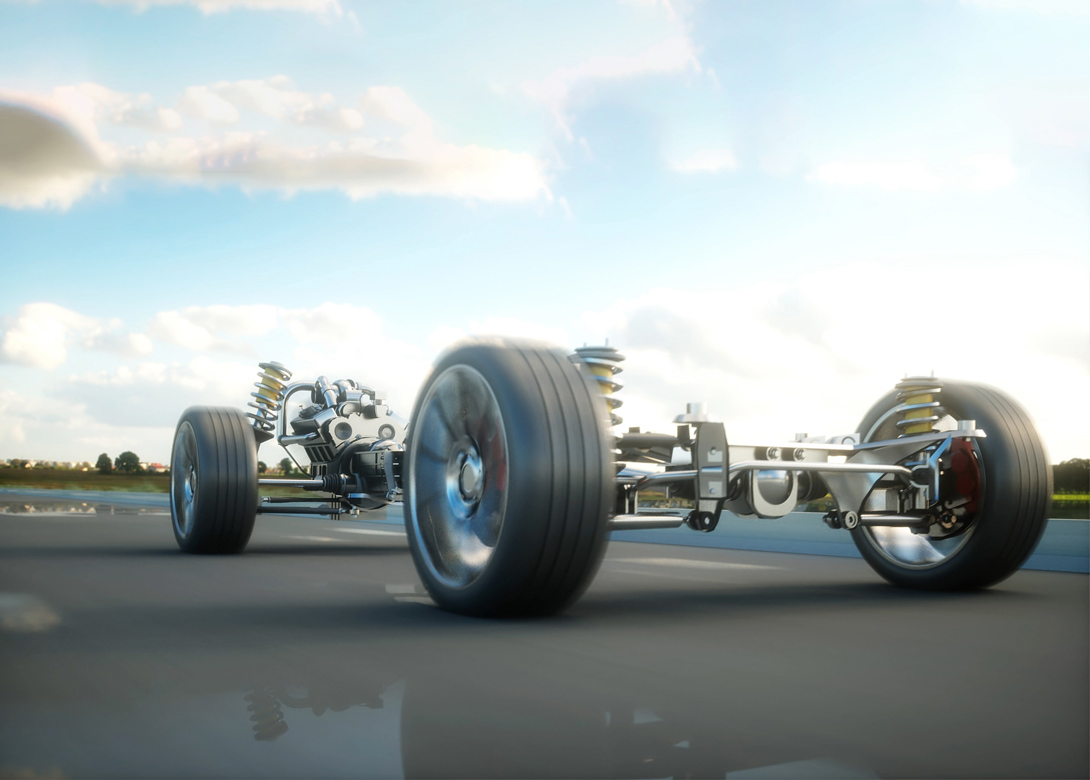
By Mareike Meer, team lead quality testing, Dörken Coatings GmbH & Co KG
Effective corrosion protection can deliver long-term functionality and operational safety of large parts and components throughout the lifetime of a vehicle as a whole.
Many of the large parts and components installed in and on cars are subjected to extensive stress and environmental influences on the road. As a result, both chassis parts and safety-relevant parts such as axle carriers or wishbones/trailing arms require long-lasting surface and corrosion protection.
A good example for this is axle carriers made from aluminium or steel. The pivot points of the wheel suspensions are secured to these – on the front axle carrier typically also the engine, gearbox and steering gear. As safety relevant and load-bearing components, the axle carriers are exposed to extreme stresses in daily use and are required to continuously withstand potholes, cracks or uneven road surfaces. In addition, they are in continuous contact with moisture, cold, heat, salt, grime and air.
Long-term, effective corrosion protection is urgently required to avoid rust and malfunction. The situation is a similar one for the wishbones, trailing arms and twist beams fitted to the chassis, which are made from steel or aluminium, depending on the class of vehicle. These are exposed to diverse environmental influences on a daily basis. Corrosion damage to any of these components would have fatal consequences for car passengers and bystanders. To ensure the lifetime and function of the components, and therefore the vehicle, especially resistant coating systems are required.
Coating options to combat corrosion
Passive corrosion protection such as a KTL coating is often used to prevent corrosive impact on the aforementioned components. KTL – cathodic dip coating – is an electro-chemical coating process in which the component is coated via direct current in a tank filled with an aqueous, electrically-separable dip coating. The thickness of the deposited coat is typically between 10μm – 40μm. An annealing process cross-links the coating layer to form a homogeneous, cohesive film. This cross-linking and the resultant barrier effect largely protect the component.
As the KTL paint also penetrates the smallest hollow spaces and is deposited there (engulfing), it is also possible to evenly coat larger components with complex structures. A second top coat – typically a powder coating – enables further properties such as individual colouring or chemical resistance to be achieved. A problem with this, the KTL coating does not achieve a cathodic corrosion protection effect. If the coating is damaged, rust can soon form.
This problem can be resolved via an innovative system from Dörken Coatings, which combines cathodic dip coating with a zinc or zinc flake base coat, thereby achieving highly capable cathodic corrosion protection.
Proven corrosion protection through zinc flake coating
Tried and tested for many years in the car industry for bolts and fasteners, high performance zinc flake coatings are also highly advantageous for large parts subjected to high levels of stress. With coats as thin as 8μm – 20μm, usually a combination of base and top coat, a protective effect of more than 1,000 hours can be achieved against base metal corrosion (red rust) in salt spray testing in accordance with DIN EN ISO 9227.
In combination with a top coat to match the respective requirements, a high degree of cathodic corrosion protection is provided, including after stone impact. This means in the event of damage to the coating the ignoble zinc in the base coat sacrifices itself on contact with water and oxygen in favour of the more noble steel base material. A further advantage is that no hydrogen is generated in the coating process, with the result that no application-related, hydrogen-induced stress corrosion cracking occurs. As a consequence, the zinc flake technology is also suitable for coating high-tensile steel (classes 10.9 and higher). The low cross-linking temperature of 220°C also avoids damaging the steel through excessive heat.
Effective corrosion protection for large car components
Large components fitted in and to cars require surface protection tailored to their requirements and area of use. Zinc flake systems are not only ideal for large components such as wishbones, trailing arms and twist beams. Even parts with complicated or intricate geometry can be coated without any problem. The internal coating of tube constructions or the coating of cavities and weld nuts is therefore also no problem. This thin coating also means that weight savings can be made – an aspect that is not only of significance in the field of lightweight construction, but also that of climate protection.
If large components in and on cars are to be given enduring and effective protection against the effects of corrosion, a zinc flake coating comprising base coat and top coat, and tailored to the respective requirements, is the recommended choice. This achieves outstanding long-term performance even with extremely thin coats, whilst also satisfying the strict requirements of the latest manufacturer quality tests.

Biog
Having spent a decade in the fastener industry experiencing every facet – from steel mills, fastener manufacturers, wholesalers, distributors, as well as machinery builders and plating + coating companies, Claire has developed an in-depth knowledge of all things fasteners.
Alongside visiting numerous companies, exhibitions and conferences around the world, Claire has also interviewed high profile figures – focusing on key topics impacting the sector and making sure readers stay up to date with the latest developments within the industry.








